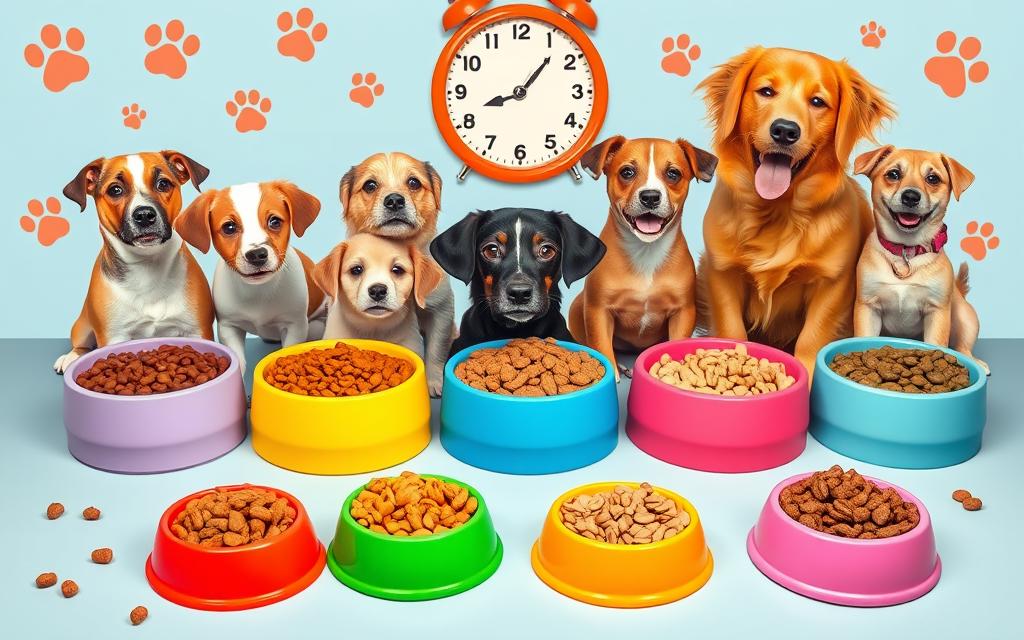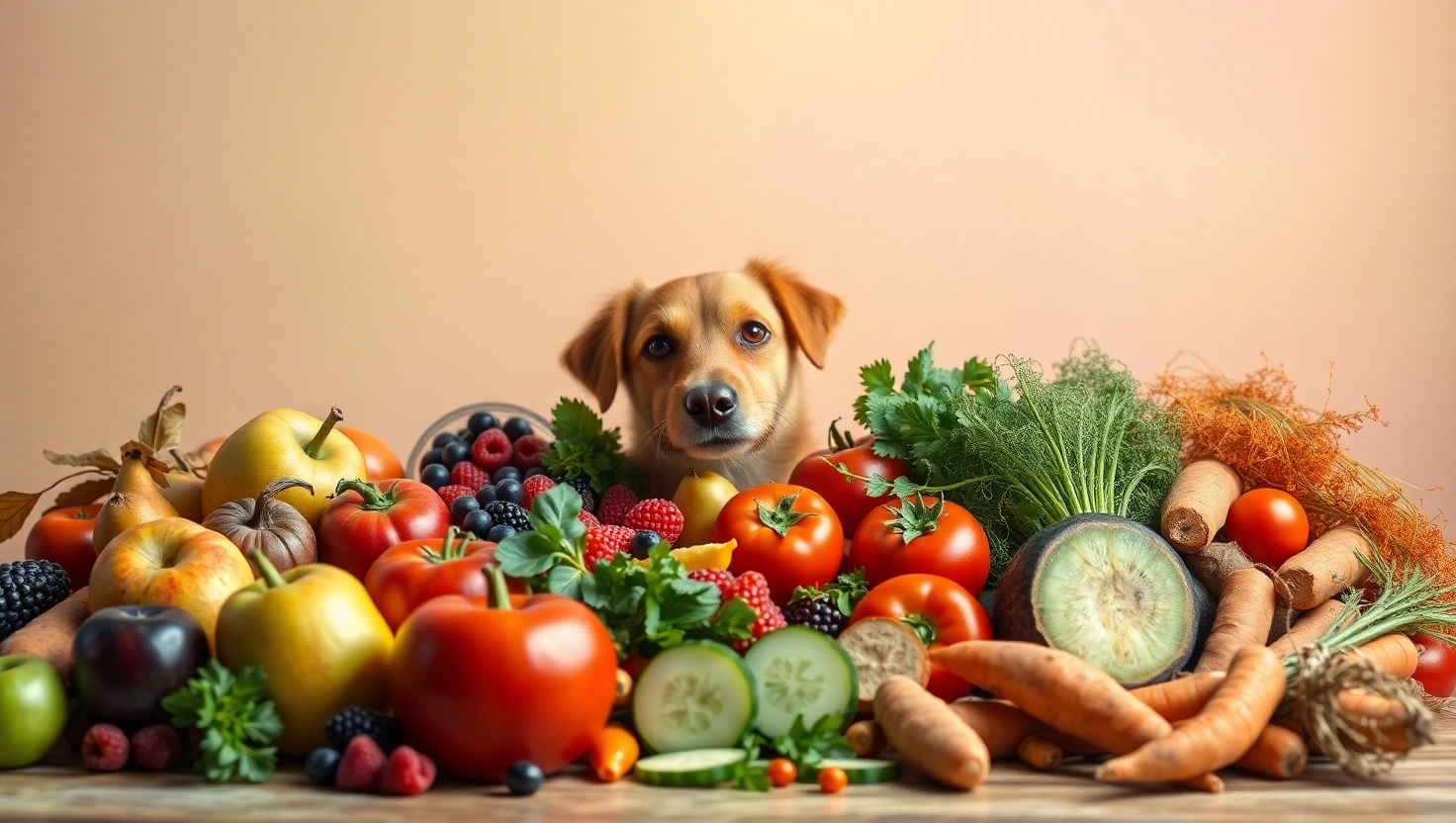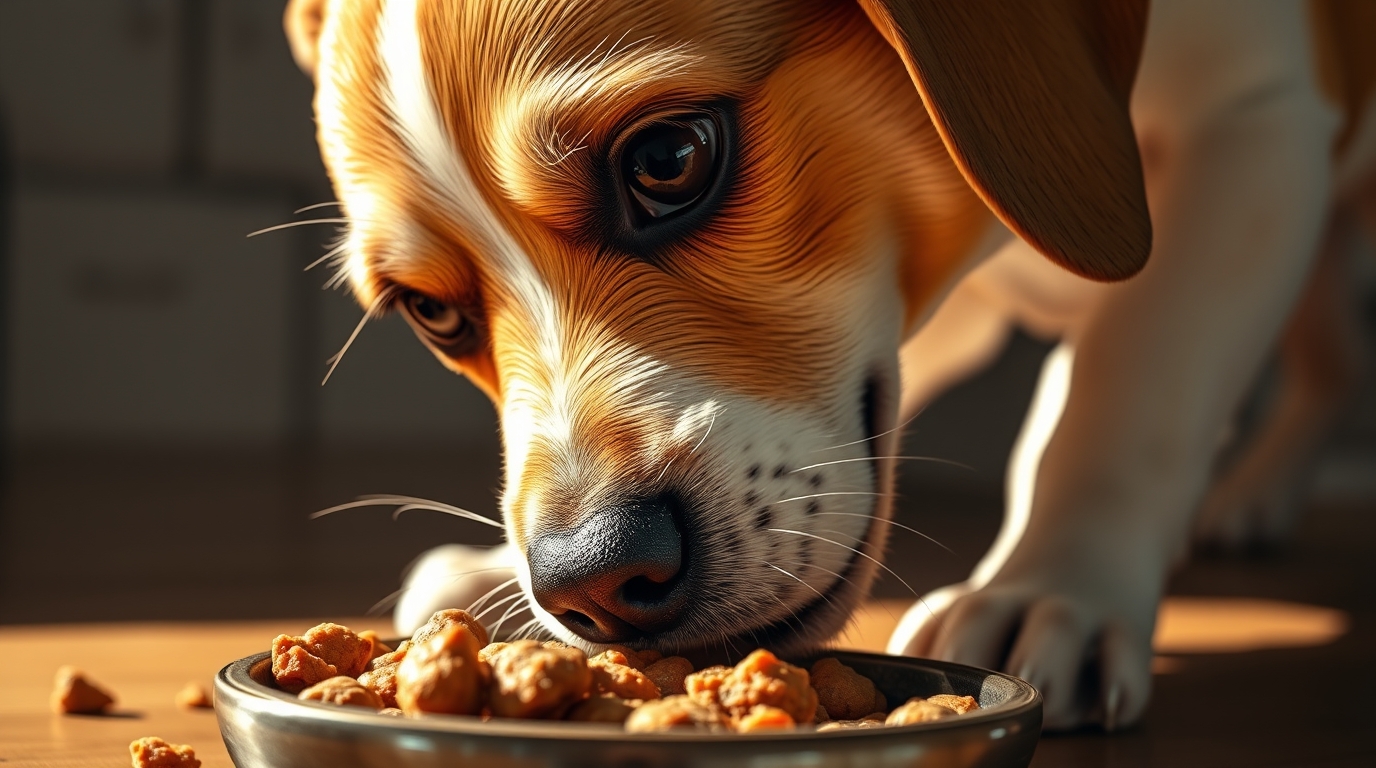Obesity in dogs is a big problem, with 59% of dogs in the U.S. being overweight or obese1. It’s important to feed them the right amount of good dog food. But finding the perfect portion size can be tricky. It depends on your dog’s age, size, how active they are, and if they’ve been spayed or neutered.
Bigger dogs eat more than smaller ones1. Dogs that are very active need more food to keep up with their busy lives1. Spayed or neutered dogs need fewer calories than those that aren’t1. Puppies need extra calories, protein, and nutrients for their growth1. Senior dogs should eat less to avoid gaining too much weight1.
Dog food labels give feeding guidelines based on your pet’s ideal weight. But these can be off by up to 50%1. Watching your dog’s body condition score and talking to your vet can help find the right amount for them.
Key Takeaways
- Portion sizes for dogs depend on factors like size, age, activity level, and reproductive status.
- Overfeeding can lead to obesity, while underfeeding may cause nutritional deficiencies.
- Feeding guidelines on dog food labels provide a starting point, but individual needs may vary.
- Monitoring your dog’s body condition and working with your veterinarian can help determine the right portion size.
- Consistent feeding schedules and portion control are important for your dog’s overall health and weight management.
Understanding Dog Nutrition Basics
Dogs are omnivores, meaning they can eat both plants and animals to get what they need2. Their bodies have special enzymes to break down carbs, which they use for energy2. For them to stay healthy, they need a diet full of six key nutrients: water, proteins, fats, carbs, minerals, and vitamins2.
Essential Nutrients for Dogs
The Association of American Feed Control Officials (AAFCO) sets rules for dog food2. Dogs get their energy from proteins and fats, but carbs can help too2. Protein is important for building and keeping tissues, muscles, and skin healthy3.
Different Types of Dog Food
Choosing between dry kibble and canned food depends on your lifestyle and budget2. Some breeds need special diets because of their origins2. Active dogs might need more than sedentary ones2.
Reading Dog Food Labels
AAFCO makes sure dog food has the right ingredients3. Labels on dog food tell you a lot, like what’s in it and how to feed it3. Knowing how to read these labels helps pick the right food for your dog’s needs3.
Factors Influencing Dog Portion Sizes
Several key factors determine the right portion size for your dog. Knowing these is crucial for your dog’s health and happiness.
Dog Size and Breed Considerations
The size and breed of a dog affect how much food they need. Big dogs like Great Danes need more than small dogs like Chihuahuas4. Using big bowls and scoops can lead to overfeeding4.
Age and Activity Level
A dog’s age and how active they are also matter. Puppies and older dogs have different needs than adult dogs5. Active dogs, like those in agility, need more food to keep up their energy.
Health Conditions
Health issues can change a dog’s food needs. Spayed or neutered dogs need fewer calories4. Dogs with diabetes or kidney disease may need special diets and portion control.
| Dog Breed | Typical Daily Portion Size |
|---|---|
| Toy Breed (e.g., Chihuahua) | 1/4 to 1 cup |
| Small Breed (e.g., Poodle) | 1 to 2 cups |
| Medium Breed (e.g., Beagle) | 2 to 3 cups |
| Large Breed (e.g., Labrador Retriever) | 3 to 4 cups |
| Giant Breed (e.g., Great Dane) | 4 to 6 cups |
Remember, these are just guidelines. Your dog’s exact needs depend on their age, activity level, and health. Always check with a vet or canine nutritionist to make sure your dog gets the right amount of food.
Recommended Feeding Guidelines for Dogs
Finding the right food for your dog is key to their health. The amount and timing of meals change based on your dog’s size, age, and how active they are.
Guidelines by Dog Size
Generally, dogs should eat 2 to 4 percent of their body weight in food each day6. For instance, a 30-pound dog might need 794 calories, while a 90-pound dog could need 1,808 calories6. You can also use the Resting Energy Requirement (RER) formula: Multiply the dog’s weight in kilograms to the power of 3/4 by 706.
Puppies vs. Adult Dogs
Puppies need more calories, protein, and carbs because they grow fast. Puppies from 0 to 4 months should eat about three times their RER. Those from 4 to 12 months should eat about two times their RER6. Senior dogs, on the other hand, should eat about 2 percent of their body weight6.
| Dog Size | Ideal Weight | Daily Calorie Intake |
|---|---|---|
| Small | 10 lbs | 346 calories |
| Medium | 30 lbs | 794 calories |
| Large | 60 lbs | 1,334 calories |
| X-Large | 90 lbs | 1,808 calories |
Knowing the right feeding guidelines for dogs of all sizes and ages helps them stay healthy and happy67.
How to Measure Dog Food Portions
It’s key to measure your dog’s food right to keep them healthy and at the right weight. Yet, many pet owners find it hard to measure dry kibble correctly8.
Using a Measuring Cup
Measuring dog food with a dry-ingredient measuring cup is easy. Studies show that a 1-cup dry-ingredient measuring cup is the best way to serve 1 cup of kibble8. Make sure to level off the cup for exact measurements. Don’t pack the food down, as it can lead to too much food.
Weighing Dog Food
For more precise measurements, especially for dogs on special diets, use a kitchen food scale8. Many pet food brands now list weight in grams on their packaging to help with portion control8.
Feeding too much can cause obesity and health problems like arthritis and diabetes9. It’s vital to watch your dog’s weight and talk to your vet about their diet9.

| Measuring Tool | Accuracy |
|---|---|
| 2-cup scoop with graduated markings | Ranged from 48% too little to 152% too much |
| 2-cup liquid measuring cup | Most likely to mismeasure all three portions |
| 1-cup dry-ingredient measuring cup | Most accurate for serving 1 cup of kibble |
To get portion sizes right, experts suggest using a matched dry-food measuring cup8. Be consistent in your measuring, measure less often, and use a kitchen food scale8.
Pet owners need to rethink how they measure dry kibble, as found in a study by the University of Guelph veterinary researchers. The study included 100 dog owners who measured dry dog food with different tools. Inaccuracies ranged from 48% too little to 152% too much. Dog owners using a 2-cup liquid measuring cup were most likely to mismeasure. Those who were most accurate used a 1-cup dry-ingredient measuring cup. Overfeeding pets can lead to obesity-related diseases. Suggestions include using a matched dry-food measuring cup, being consistent, measuring less often, and using a kitchen food scale. Some pet food manufacturers include weight measurements in grams on their packaging for accurate portion control9.
Pet obesity is a big problem in the United States. Overfeeding can cause health issues like arthritis and diabetes. It’s recommended to limit dog treats to no more than 10% of their daily caloric intake. Veterinarians use a body conditioning score (BCS) scale from one to nine to evaluate a dog’s body fat level. The BCS scale ranges from emaciated (score of 1), to ideal weight (scores of 4 and 5), overweight (score of 6), obese (score of 7), heavy (score of 8), and severely obese (score of 9). Monitoring a dog’s weight and BCS every two to four weeks is recommended to spot inappropriate weight changes. Senior pets typically have a slower metabolism, so their portion sizes may need adjustment. Consult your veterinarian for tailored advice on your dog’s weight status and dietary requirements.
Establishing Feeding Schedules
Keeping a regular dog feeding schedule is key for your pet’s health. Having set meal times helps create a daily routine. It also aids in house training, especially for puppies and rescue dogs10.
Importance of Consistent Feeding Times
Feeding your dog at the same times each day helps them know when to eat. It also helps their digestive system work better. Plus, it makes it easier to keep an eye on how much they eat and spot health problems early. It also helps with house training, as dogs usually need to go to the bathroom after eating10.
How Many Meals Per Day?
Most adult dogs should eat at least twice a day, about 12 hours apart10. This stops stomach problems and keeps them from getting sick. Puppies and small dogs need to eat more often, with smaller meals that are easier on their stomachs11.
| Dog Size | Puppy (Up to 4 Months) | Adult and Senior |
|---|---|---|
| Large Breeds | 3 meals per day | 2-3 meals per day |
| Small/Medium Breeds | 3 meals per day | 2 meals per day |
| Toy Breeds | 4-5 meals per day | 2 meals per day |
Keeping a regular feeding schedule and the right meal frequency is good for your pet’s health. A routine ensures they get the right food and helps them stay active101112.
Adjusting Portion Sizes for Weight Management
Keeping your dog at a healthy weight is very important. Dogs can sometimes gain a bit of weight, but too much can be harmful. It’s crucial to notice if your dog is overweight and adjust their food intake to manage their weight.
Signs Your Dog is Overweight
One way to tell if your dog is overweight is if you can’t feel their ribs easily. You should be able to feel their ribs without too much fat in the way.13 Another sign is if you can’t see their waistline from above. A healthy dog should have a clear waistline between their ribcage and hips.13
Caloric Needs for Weight Loss
To help your dog lose weight, you should cut their calories by 3 to 5 percent each month. This means they could lose about one pound a week or four pounds a month if they weigh 100 pounds.13 Overweight dogs are more likely to get diseases like diabetes, heart problems, and some cancers.14
Changing your dog’s food portions for weight loss needs a vet’s advice. They should get a diet that’s lower in calories, higher in protein, and has more fiber to help them feel full.14 Regular weigh-ins and checks will help you see how they’re doing and adjust their diet as needed.
Keeping your dog at a healthy weight is key to their happiness and health. By spotting the signs of too much weight and working with your vet, you can help them stay healthy. With the right plan and care, your dog can live a long, happy, and healthy life.
Common Mistakes in Dog Feeding
We all want the best for our dogs. But, we can make mistakes in feeding them. Two big errors are free feeding and giving too many treats15.
Free Feeding vs. Scheduled Feeding
Free feeding means the dog’s bowl is always full. This can cause them to eat too much and gain weight15. Scheduled feeding helps control how much they eat. It also helps keep their diet regular, which is good for their health and weight.
Overreliance on Treats
Treats are great for rewarding and bonding with our dogs. But, we should not give them too many15. Too many treats can make them gain weight and upset their diet. Experts say treats should not be more than 10% of their daily food15.
To avoid these mistakes, we need to know what our dogs need to eat. We should also know how much and when to give treats. By making smart choices and sticking to a routine, we can make sure our dogs are healthy and happy16.
| Feeding Mistake | Potential Consequences | Recommended Approach |
|---|---|---|
| Free Feeding | Overeating and obesity | Scheduled feeding for portion control |
| Overreliance on Treats | Weight gain and nutritional imbalances | Limit treats to 10% of daily caloric intake |
Tips for Transitioning Dog Food
Changing your dog’s food needs patience and planning. Whether it’s a new brand, formula, or diet, start slowly to avoid upset stomachs17.
Gradually Introducing New Foods
Take 7-10 days to switch your dog’s food17. Begin by mixing 25% new food with 75% old food. Then, slowly add more new food17. This gradual change helps your dog’s stomach adjust and prevents vomiting or diarrhea18.
Dogs with sensitive stomachs or allergies might need an even slower transition, up to 2 weeks18. Watch your dog closely and adjust the pace if needed.
Monitoring for Allergies or Reactions
Keep an eye out for signs like itching, vomiting, or diarrhea when introducing new food18. These could mean your dog has a food allergy or intolerance. You might need to talk to your vet to find out what ingredient is causing the problem18.
If your dog gets upset stomach during the change, slow down even more or try a different food18. Use a Fecal Scoring Chart to check how well your dog is tolerating the new food18.
Choosing the right dog food is very personal. What works for one dog might not work for another18. Be patient, watch your dog closely, and don’t hesitate to ask your vet for help18.

Changing your dog’s diet doesn’t have to be hard. Follow these tips and pay attention to your pet’s needs. This way, you can make the transition smooth and successful1718.
Seeking Professional Advice
General feeding guidelines are a good start, but sometimes you need a vet’s advice. This is especially true for puppies, older dogs, or those with health issues19. A vet can help tailor a diet plan that meets your dog’s specific needs20.
When to Consult Your Veterinarian
Regular vet visits are key to adjusting your dog’s diet as they grow or their health changes19. Dogs with health problems like diabetes or kidney disease need special diets20. Your vet can guide you on the right food amounts and nutrients for your dog’s health.
Nutritional Counseling for Dogs
Vet nutritional counseling goes beyond health issues. It helps understand your dog’s dietary needs in detail20. This includes the right balance of proteins, carbs, fats, vitamins, and minerals19. Working with your vet ensures your dog gets the best diet for their health and happiness.




